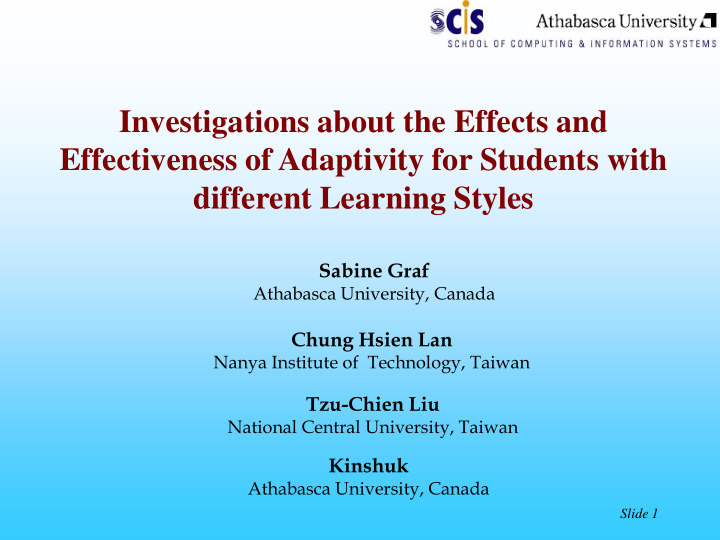



Investigations about the Effects and Effectiveness of Adaptivity for Students with different Learning Styles Sabine Graf Athabasca University, Canada Chung Hsien Lan Nanya Institute of Technology, Taiwan Tzu-Chien Liu National Central University, Taiwan Kinshuk Athabasca University, Canada Slide 1
Learning Styles • Many learning style models exist in literature • Considering learning styles in education has potential to make learning easier – Argued by educational theorists – Based on these arguments, several adaptive learning systems have been developed – Several evaluations of these systems has been conducted – Some results confirm that adaptivity can help students in learning, others do not Slide 2
Aim of our Research • Most evaluations check whether considering learning styles in online courses helps students in learning or not • Our evaluation investigates the effects and effectiveness of adaptivity for students with different learning styles – Does students with different learning styles benefit from adaptivity in different ways? Effects of adaptivity for students with different learning styles – Which students can be supported more effectively by using adaptivity comparing their learning styles? Effectiveness of adaptivity comparing different learning styles Slide 3
A Concept for Providing Adaptivity • This study is based on and uses data from a project about adaptivity in learning management systems • Moodle has been used as prototype for the developed adaptive mechanism • Felder-Silverman learning styles model has been used to describe learning styles Slide 4
Felder-Silverman learning style model • Each learner has a preference on each of the dimensions • Dimensions: – Active – Reflective – Sensing – Intuitive – Visual – Verbal – Sequential – Global • Differences to other learning style models: – Combines major learning style models – New way of combining and describing learning styles – Describes tendencies – Describes learning style in more detail Slide 5
Adaptive Mechanism • Main aim was to keep the effort of authors/teachers as little as possible excluded visual/verbal dimension • Incorporates only common kinds of learning objects – Content – Outlines – Conclusions – Examples – Self-assessment tests – Exercises Slide 6
Adaptive Mechanism • Adaptivity is provided on a general basis • Adaptive features include – Changing the number of types of LOs – Changing the sequence of types of LOs • Adaptive courses were recommendations, students could access all LOs and go through them in whatever sequence they preferred Slide 7
Study Design • Course about object oriented modelling • Lecture and practical part where students had to submit 5 assignments • Randomly assigned to 2 groups: – Courses that fit to the students’ learning styles (matched group) [75 students] – Courses that do not fit to the students’ learning styles (mismatched group) [72 students] • Procedure – Students filled out the ILS questionnaire – Adaptive course was automatically generated and presented Slide 8
Effects of Adaptivity • Comparing data from matched and mismatched course with respect to learning styles and behaviour/performance variables (using ANOVA) • Learning Styles: – Two groups for each dimension (e.g., active and reflective) • Performance – Scores of final exam • Behaviour – Time spent on learning activities – Number of logins – Number of visited learning activities – Number of requests for additional LOs Slide 9
Effects of Adaptivity - Results Means: Matched: 4.45 h Mism.: 6.29 h active reflective sensing intuitive sequential global final_exam F 2.276 0.451 3.613 0.174 0.793 0.937 p 0.136 0.504 0.06 0.678 0.376 0.336 time F 7.888 * 3.856 1.754 0.339 4.271 * 0.038 p 0.006 0.054 0.189 0.563 0.043 0.846 numlogin F 3.937 0.11 1.28 0.012 1.356 0.014 p 0.052 0.741 0.262 0.915 0.249 0.906 numLO F 1.54 4.639 * 4.084 * 0.509 2.173 0.29 p 0.219 0.035 0.047 0.479 0.145 0.592 numALO_p F 1.486 1.668 0.867 4.531 * 4.442 * 5.741 * p 0.227 0.037 0.038 0.202 0.41 0.019 Means: Means: Means: Matched: 6.25% Matched: 624.73 Matched: 413.33 Mism.: 8.99% Mism.: 433.83 Mism.: 545.17 Means: Means: Means: Matched: 3.81 h Matched: 6.07% Matched: 5.46% Mism.: 6.00 h Slide 10 Mism.: 8.27% Mism.: 7.91%
Effectiveness of Adaptivity • Which students can be supported more effectively by using adaptivity comparing their learning styles? • Looking only at data from matched course and comparing the students‘ performance and behaviour with respect to their learning styles Slide 11
Effectiveness of Adaptivity Means: Act.: 166.07 points Ref.: 184.37 points act/ref sen/int seq/glo Means: final_exam F 0.490 8.862 * 5.127 * Sen.: 169.98 points p 0.004 0.027 0.486 Int.: 185.43 points time F 0.018 0.180 8.063 * Means: p 0.006 0.893 0.672 Act.: 3.81 h numlogin F 3.866 2.806 4.586 * Ref.: 6.68 h p 0.036 0.054 0.099 Means: numLO F 1.370 0.003 6.635 * Act.: 27.24 p 0.012 0.246 0.953 Ref.: 31.08 numALO_p F 2.649 0.131 0.055 Means: p 0.108 0.718 0.816 Act.: 415.21 Ref.: 624.73 Slide 12
Conclusions • Adaptivity based on learning styles can help students in learning • Adaptivity has different effects for learners with different learning styles • Findings give a deeper insight in the effects and effectiveness of adaptivity • Findings show that for some learning styles adaptivity works better than for others, in terms of encouraging them to use the course more intensively and/or letting them achieve better scores. Slide 13
Future Work • Investigating interactions of the three learning style dimensions • Investigating whether combinations of learning styles exists which have more impact on supporting learners • How generic are our results – Do they show only possible benefits of adaptivity depending on the concept used for providing adaptivity? – Does results appear in general when adaptivity is provided? Slide 14
Recommend
More recommend